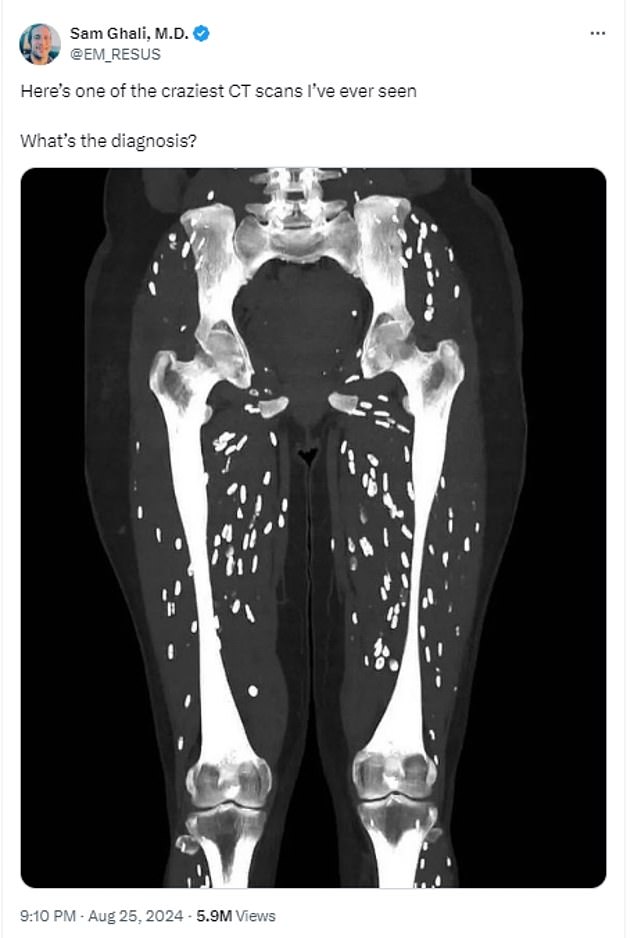The dangers of eating undercooked pork have been revealed in a horrific body scan which shows the parasites that can infect the body through contaminated meat.
Dr. Sam Ghali, an emergency physician at the University of Florida, took to social media to share an image of a patient with telltale signs of a parasitic infection called cysticercosis.
Cysticercosis occurs when the larvae of a species of tapeworm penetrate tissues such as muscle or even the brain.
They form a hard calcified cyst that can be felt as lumps under the skin and appear as oval white nodules shaped like “grains of rice” on medical scans.
Although unpleasant, they are usually harmless, as the larvae do not survive outside the intestine. However, the cysts can cause problems if they develop in the brain.
Dr. Sam Ghali, an American emergency response physician, shared a photograph of an anonymous patient with telltale signs of a parasitic infection called cysticercosis.
The tapeworm responsible for the infection enters the human body through the consumption of its eggs.
These eggs can be found in undercooked pork and can develop into adult tapeworms in the intestines of people, but this does not directly cause cysticercosis.
Cysticercosis, on the other hand, occurs when infected people transmit tapeworm eggs to others through their feces.
Writing about X, Dr Ghali said: “It is very important to note that only when these eggs are ingested through fecal-oral transmission, one can develop the clinical syndrome known as cysticercosis.”
This transmission occurs mainly when infected people do not wash their hands properly after using the bathroom, although eggs can also be transmitted through water contaminated with fecal matter.

The tapeworm species responsible is called Taenia solium (pictured) and can infect people through contaminated feces and pork products.
Once ingested in this way, the eggs release larvae that can pass into the bloodstream and end up in places such as muscles or other organs.
Here they are destroyed by the body’s immune system and form hard cysts.
Headaches and even seizures are common when cysts enter the brain, as well as confusion, dizziness and a potentially fatal condition called hydrocephalus, an excess of fluid in the brain.
Generally in these cases surgery is required to remove the cysts.
Cysts can also cause problems if they reach the eyes, causing blurred or altered vision and potentially triggering an infection.
The cysts themselves may not develop until months or years after the initial infection with tapeworm eggs.
The tapeworm that can cause cysticercosis is a species called Taenia solium, also known as the pork tapeworm.
The World Health Organization estimates that Taenia solium larval cysts that develop in the brain are responsible for up to 70 percent of epilepsy cases in some parts of the world.

Even more extraordinary infections have been recorded in the past; here is an example from a patient in Brazil
It is believed that around 2.5 million people are infected with Taenia solium each year, most often in poorer regions of Asia, South America and Eastern Europe.
Dr Ghali added: “The prognosis for cysticercosis is generally good, but unfortunately some cases are fatal. It is estimated that around 50 million people worldwide are infected each year, resulting in around 50,000 deaths.”
‘So the moral of the story is to do everything you can to stay clean, always wash your hands and never, ever eat raw or undercooked pork.’
While the analysis shared by Dr. Ghali is typical, there have been cases reported where patients have hundreds of tapeworm cysts in their bodies.
These include a shocking case reported in Brazil last year.


